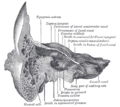Carotid canal
| Carotid canal | |
|---|---|
 Left temporal bone. Inferior surface. ("Opening of carotid canal" labeled at center left.) | |
| Details | |
| Part of | temporal bone |
| System | skeletal |
| Identifiers | |
| Latin | canalis caroticus |
| TA98 | A02.1.06.013 |
| TA2 | 651 |
| FMA | 55805 |
| Anatomical terms of bone | |
The carotid canal is a passageway in the temporal bone of the skull through which the internal carotid artery enters the middle cranial fossa from the neck.
Structure[]
The carotid canal starts on the inferior surface of the temporal bone of the skull at the external opening of the carotid canal (also referred to as the carotid foramen). The canal ascends at first superiorly, and then, making a bend, runs anteromedially. Its internal opening is near the foramen lacerum, above which the internal carotid artery passes on its way anteriorly to the cavernous sinus.[1]
Function[]
The carotid canal allows the internal carotid artery to pass into the cranium,[1][2] as well as the carotid plexus traveling on the artery.[1]
The carotid plexus contains sympathetics to the head from the superior cervical ganglion.[1] They have several motor functions: raise the eyelid (superior tarsal muscle), dilate pupil (pupillary dilator muscle), innervate sweat glands of face and scalp and constricts blood vessels in the head.
Clinical significance[]
Any skull fractures that damage the carotid canal can put the internal carotid artery at risk.[3] Angiography can be used to ensure that there is no damage, and to aid in treatment if there is.[3]
Additional images[]

Horizontal section of nasal and orbital cavities.

Coronal section of right temporal bone.
Carotid canal.
References[]
![]() This article incorporates text in the public domain from page 143 of the 20th edition of Gray's Anatomy (1918)
This article incorporates text in the public domain from page 143 of the 20th edition of Gray's Anatomy (1918)
- ^ a b c d Kumar, Amarendhra M.; Roman-Auerhahn, Margo Ruth (2005-01-01). "1 - Anatomy of the Canine and Feline Ear". Small Animal Ear Diseases (2nd ed.). Saunders. pp. 1–21. doi:10.1016/B0-72-160137-5/50004-0. ISBN 978-0-7216-0137-3.
{{cite book}}: CS1 maint: date and year (link) - ^ Maynard, Robert Lewis; Downes, Noel (2019-01-01). "7 - The Cardiovascular System". Anatomy and Histology of the Laboratory Rat in Toxicology and Biomedical Research. Academic Press. pp. 77–90. doi:10.1016/B978-0-12-811837-5.00007-1. ISBN 978-0-12-811837-5.
{{cite book}}: CS1 maint: date and year (link) - ^ a b Houseman, Clifford M.; Belverud, Shawn A.; Narayan, Raj K. (2012). "20 - Closed Head Injury". Principles of Neurological Surgery (3rd ed.). Saunders. pp. 325–347. doi:10.1016/C2009-0-52989-3. ISBN 978-1-4377-0701-4.
External links[]
- Atlas image: n3a8p1 at the University of Michigan Health System
- "Anatomy diagram: 34257.000-1". Roche Lexicon - illustrated navigator. Elsevier. Archived from the original on 2012-07-22.
- Photo at Winona.edu
- Wikipedia articles incorporating text from the 20th edition of Gray's Anatomy (1918)
- Foramina of the skull


